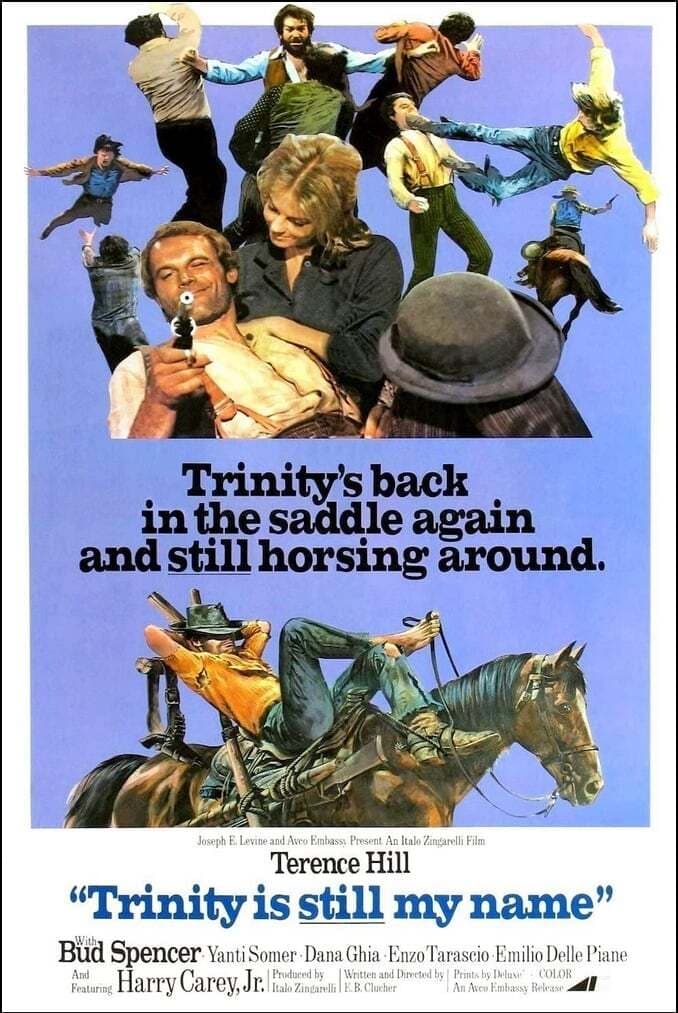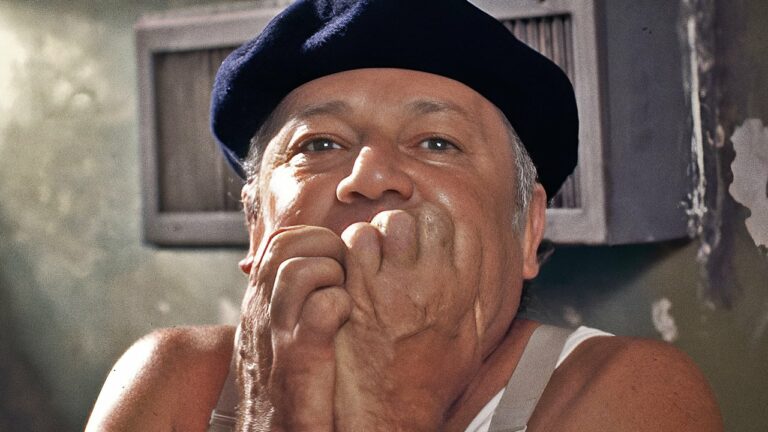
The 1969 Italian film Sabata (Ehi amico… c’è Sabata, hai chiuso!, translated as “Hey Friend… That’s Sabata, You’re Finished!”) is a quintessential Spaghetti Western that exemplifies the genre’s trademark blend of stylized action, quirky characters, and morally ambiguous storytelling. Directed by Gianfranco Parolini under the pseudonym Frank Kramer, Sabata features a riveting performance by Lee Van Cleef in the titular role. The film quickly earned a reputation as a classic of the genre, spawning two sequels and cementing its place in the pantheon of Italian Westerns.
This article takes an in-depth look at the origins, themes, characters, and legacy of Sabata, exploring how it reflects the key characteristics of Spaghetti Westerns while carving out its unique identity.
Plot Summary: Sabata’s World of Greed, Corruption, and Retribution
The story of Sabata is set in the post-Civil War American West, where greed and corruption rule the day. The film opens with the theft of $100,000 from a bank in the town of Daugherty. Sabata (Lee Van Cleef), a mysterious, sharpshooting drifter, arrives in town and quickly recovers the stolen money. However, his act of heroism turns out to be only the beginning of a much larger and more intricate plot.
Sabata uncovers a conspiracy involving the town’s elite, including Stengel (Franco Ressel), a wealthy landowner; Judge O’Hara (Gianni Rizzo); and Ferguson (Antonio Gradoli). These powerful figures orchestrated the robbery to finance a land deal and enrich themselves at the expense of the townspeople.
Using his cunning and expert marksmanship, Sabata blackmails the conspirators, demanding a share of their profits in exchange for his silence. What follows is a cat-and-mouse game filled with betrayal, elaborate schemes, and over-the-top showdowns. Along the way, Sabata teams up with a colorful cast of characters, including the acrobatic Alley Cat (played by William Berger) and the eccentric Banjo (Ignazio Spalla, billed as Pedro Sanchez), whose motives remain ambiguous until the film’s climactic moments.
The plot is a hallmark of Spaghetti Westerns, blending action, intrigue, and a cynical view of human nature. Sabata thrives on its twists, with Sabata always staying one step ahead of his adversaries in a battle of wits and bullets.
Themes: Cynicism, Greed, and Justice in the Wild West
1. Greed and Corruption
Sabata delves into the corrupting influence of wealth and power, a recurring theme in Spaghetti Westerns. The town’s leaders, who are supposed to represent law and order, are exposed as criminals willing to betray their community for personal gain. The film critiques the hypocrisy of authority figures, presenting them as far more morally bankrupt than the outlaws they condemn.
2. Morally Ambiguous Heroes
Sabata embodies the archetypal antihero of Spaghetti Westerns: charismatic, resourceful, and morally flexible. While he does recover the stolen money, his primary motivation is personal gain. However, his wit, skill, and sense of justice make him a likable and compelling protagonist.
3. Individualism vs. Authority
The film’s narrative celebrates individualism, with Sabata acting as a lone force of retribution against a corrupt establishment. His independence and self-reliance contrast sharply with the conspirators’ greed-driven collaboration.
4. Revenge and Retribution
At its core, Sabata is a tale of revenge and justice. The film thrives on the tension between Sabata’s personal vendettas and his ultimate goal of exposing corruption.
Gianfranco Parolini’s Direction: Stylized Action and Visual Flair
Director Gianfranco Parolini, known for his energetic and innovative approach to filmmaking, brought a distinctive style to Sabata.
1. Action and Spectacle
Parolini’s direction is characterized by inventive action sequences that push the boundaries of the genre. The film features everything from gunfights and acrobatics to unexpected moments of dark humor. Sabata’s ingenious gadgets, such as his trick rifle and booby-trapped revolver, add a layer of creativity and fun to the action.
2. Visual Storytelling
Parolini uses dynamic camera work, striking compositions, and close-ups to heighten the tension and drama. His use of the widescreen format captures the sprawling landscapes and intensifies the film’s larger-than-life feel.
3. Playful Tone
Unlike the grittier Spaghetti Westerns of Sergio Leone, Sabata incorporates a playful, almost comic-book-like tone. The quirky supporting characters, colorful villains, and exaggerated action sequences give the film a sense of irreverence that distinguishes it from its contemporaries.
Lee Van Cleef: The Quintessential Spaghetti Western Star
Lee Van Cleef’s portrayal of Sabata is one of the film’s standout elements. Already a veteran of the genre thanks to his roles in Sergio Leone’s For a Few Dollars More and The Good, the Bad and the Ugly, Van Cleef brought a mix of gravitas, charm, and menace to the role.
Sabata’s calm demeanor, razor-sharp wit, and unmatched skill with a gun make him an iconic Spaghetti Western hero. Van Cleef’s rugged appearance and piercing eyes perfectly suit the character, and his performance solidified his status as one of the genre’s most beloved stars.
Supporting Cast: Eccentric Allies and Villains
1. William Berger as Alley Cat
Alley Cat, Sabata’s acrobatic ally, adds a unique physicality to the film. Berger’s performance is filled with charisma and humor, and his character’s daredevil stunts provide some of the film’s most memorable moments.
2. Ignazio Spalla (Pedro Sanchez) as Banjo
Banjo, a mysterious drifter with a penchant for music and guns, is one of the film’s most enigmatic characters. Spalla’s performance keeps the audience guessing about Banjo’s true loyalties, adding an intriguing layer of complexity to the story.
3. Franco Ressel as Stengel
As the film’s primary antagonist, Stengel embodies arrogance and greed. Ressel’s portrayal of the villain is both menacing and flamboyant, making him a fitting foil for Sabata.
Music: A Memorable Score by Marcello Giombini
The film’s score, composed by Marcello Giombini, is an essential part of its identity. Giombini’s music features a mix of orchestral arrangements, whistling motifs, and jaunty melodies, reflecting the film’s playful tone. The main theme, with its distinctive use of guitar and percussion, is instantly recognizable and remains one of the standout soundtracks of the genre.
Legacy and Influence
1. A Cult Classic
Sabata was a commercial success upon its release, earning a loyal following and spawning two sequels: Adiós, Sabata (1970) and Return of Sabata (1971). While Lee Van Cleef reprised his role in the third installment, the second film featured Yul Brynner as the lead character, marking a notable departure from the original formula.
2. Expanding the Spaghetti Western Genre
The film’s mix of humor, action, and stylized storytelling helped broaden the appeal of Spaghetti Westerns. While many films in the genre leaned toward darker and more nihilistic themes, Sabata demonstrated that Spaghetti Westerns could also be entertaining and lighthearted without losing their edge.
3. Influence on Modern Cinema
The creativity and irreverence of Sabata have influenced filmmakers in and beyond the Western genre. Its combination of quirky characters, inventive gadgets, and antihero protagonists can be seen in later works, from Quentin Tarantino’s Django Unchained to modern action-comedies.
FAQs
1. What is Sabata about?
The film follows Sabata, a skilled gunslinger, as he uncovers and blackmails a group of corrupt town officials who orchestrated a bank robbery.
2. Who directed Sabata?
The film was directed by Gianfranco Parolini under the pseudonym Frank Kramer.
3. What makes Sabata unique among Spaghetti Westerns?
Its playful tone, inventive action sequences, and colorful characters set it apart from the darker and grittier entries in the genre.
4. Who stars in the film?
Lee Van Cleef stars as Sabata, with notable performances by William Berger, Ignazio Spalla, and Franco Ressel.
5. How many films are in the Sabata series?
The series includes three films: Sabata (1969), Adiós, Sabata (1970), and Return of Sabata (1971).
Conclusion
Sabata is a quintessential Spaghetti Western that combines action, humor, and social critique into a thoroughly entertaining package. With its charismatic lead, inventive direction, and memorable score, the film remains a beloved classic of Italian cinema. Whether you’re a seasoned fan of Spaghetti Westerns or a newcomer to the genre, Sabata offers a thrilling ride through the lawless and morally ambiguous world of the Wild West.






